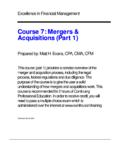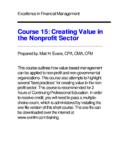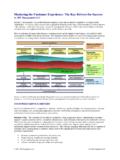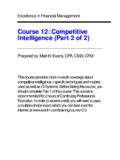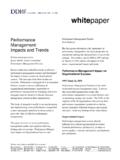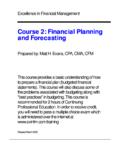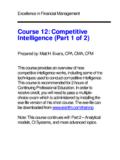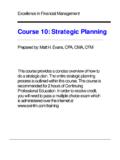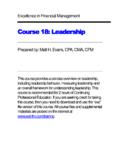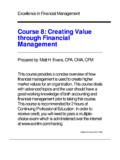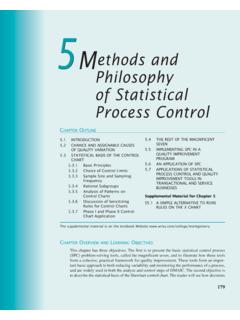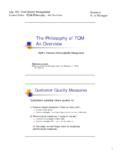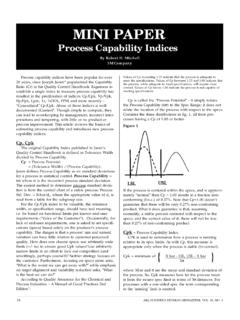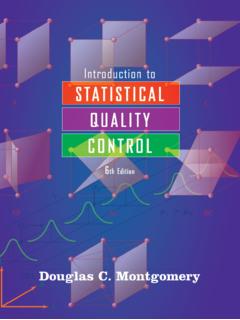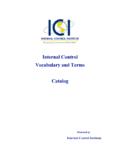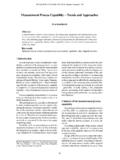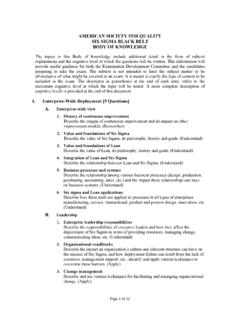Transcription of Course17:Process Improvement - exinfm
1 Excellence in Financial Management Course 17: process Improvement Prepared by: Matt H. Evans, CPA, CMA, CFM. This course provides an overall understanding of how to improve processes. This course is recommended for 2. hours of Continuing Professional you are seeking credit for taking this course, then you need to download and use the exe file version of this course files and supplemental materials are posted on the internet at Chapter 1. Some Good Starting Points Everything everyone does within an organization is part of a process . So invariably if you want to improve what the organization does, then you have to focus on improving the process . By putting your emphasis on the process , you avoid the typical trap that so many business leaders seem to fall prey to looking to cut costs, they focus on trimming payrolls or pushing people to do more with less.
2 This short-sided approach may get a brief bump in performance. However, in the long-run you end up increasing costs, reducing value to the customer, and making it harder for the company to compete. process Improvement is a long-term approach to improving organizational performance with substantially less risks of destroying value when compared to short-term approaches. This short course will outline many of the concepts and tools people use to improve processes. The word quality will be used a lot since we will learn that variations are the opposite of quality and by reducing variation (improving quality), we can embark on the road to continuously improving a process . Two Important Pioneers process efficiency, especially in the name of quality, has been around for a long time.
3 For example, back in 1950 W. Edwards Deming spoke before Japanese business leaders, outlining a roadmap for total quality management. Deming's roadmap consisted of fourteen key points: 1. Create a constancy of purpose so that you are continuously improving your processes. This requires defining both short term and long term problems, allocating resources appropriately, and working to improve product and service design. 2. Adopt a new philosophy of quality management, constant learning, embracing change and focus on the customer. 3. Cease dependence on inspection as a means for ensuring quality. Instead, place much more reliance on statistical tools for assessing quality. 4. Don't award simply on lowest price.
4 Change your focus from lowest initial costs to lowest overall costs in the long run, incorporating quality, sole source, relationships, and other factors. 5. Search continuously to improve processes. Become innovative and look at the overall process flow or system in terms of design, inputs, materials, maintenance, supervision, automation, training, teams, waste, and other areas that generate innovation. 6. Invest in great training to keep your people productive and innovative. New skills bring about improvements. Therefore, you must fuel this process by empowering your people to do their best. 7. Institute leadership that goes beyond the numbers and instead, puts an emphasis on supporting and making sure people can execute.
5 Leadership must be able to discern what's important and what's not to optimize how resources are applied. 2. 8. Drive out fear and encourage people to participate and openly pursue needed improvements and change. 9. Break down the barriers with workers, suppliers, and everyone involved in the process . Promote communication across all players. 10. Eliminate slogans, exhortations, and targets that tend to be divisive and counter- productive to one group of players within the process . 11. Avoid numerical quotas since they impede quality, increase waste, and discourage productivity. 12. Allow pride of workmanship and do away with the traditional approaches of annual performance appraisals and management by objectives.
6 Evaluate and reward performance in relation to quality. 13. Institute educational programs and self- Improvement for life long learning and team building. 14. Make sure Senior Management is committed to improving quality and productivity. This may require changing the organizational structure and putting an Action Plan in place for the 13 other points. Needless to say the Japanese took Deming very seriously, producing high quality products and capturing global markets for their products. So it is very clear that Deming was well ahead of his time and many of his principles are now widely practiced throughout the world. A second pioneer behind the quality management movement is Joseph M. Juran. Juran, like Deming, advocated strong participation by everyone touched by the process .
7 However, Juran took this concept one step further by including the customer. Juran argued that quality must be linked to the customer. Juran documented his principles in a landmark book, Quality Control Handbook, in which he put heavy emphasis on understanding and measuring the customer. Here is a list of Juran's ten step process : 1. Identify your customers 2. Seek out and define their needs 3. Translate customer needs into your business language and requirements 4. Establish units of measure 5. Define appropriate performance measurements 6. Develop products and services 7. Optimize product and service design 8. Develop production processes 9. Optimize processes / fully capable 10. Transfer into operations For those wanting to learn how to improve a process , W.
8 Edwards Deming and Joseph M. Duran are two of the best sources. Production technique is pretty much a level playing field. Anyone can purchase identical equipment and facilities, hire and train qualified people, and purchase raw materials required to make a product. There are certain steps required to make a particular product and everyone does them the same way. The difference appears to be in the manufacturing technique how we manage and balance people, materials, and machines.. Lean Manufacturing that Works by Bill Carreira 3. Breaking it Down A process is a series of activities, often repeated over and over with the basic flow of transforming inputs into outputs. The basic premise can be depicted as follows: Control your inputs Activities blend the inputs to Measure to reduce variation produce outputs (products Performance Little and services) Waste, Low Costs, High Quality, etc.
9 Proc ess In puts (Ac ti vitie s) Outp ut s The activities that make up the process are not the same. Some activities add value to a process and other activities fail to add value. Therefore, one way to think process Improvement is to think in terms of reducing non-value added activities. The concept of value-added is not easy to pin down. We can borrow from lean thinking (which we will discuss later) to help define value added. Under lean, the activity needs to contribute in some way to adding value to the customer. So in order to understand if an activity is value-added, you must understand what adds to the customer experience. Maybe it's something that gets the product to the customer sooner or perhaps it's an after the sale phone call that makes the product or service more complete.
10 We need to distinguish between value added vs. non value added in relation to the customer. This often boils down to getting the process to do only the right things in the right sequence at the right times and everything else is subject to the non-value added test. The concept of Lean tends to flag non value added activities into seven categories: 1. Overproduction The application of work that is not really needed. 2. Waiting Time spent where resources are idle, not used for anything. 3. Transportation Having to move resources from one location to another which introduces delay and inefficiency. 4. Nonessential activity Performing an activity that makes no contribution to putting value into the hands of the customer.
